Fluids in Space
About Microgravity
What does it mean to be “weightless”?
We have all seen images, such as the one at the right, of astronauts floating inside a spacecraft. If these astronauts used a spring scale to weigh themselves, they would detect no weight at all. Does no weight mean no gravity?
There certainly is gravity in the space around Earth, and that's what holds satellites in their orbits. Spacecraft with astronauts typically orbit at an altitude of only about 400 km (250 mi), and the acceleration of gravity at this distance is about 90% of its value on the surface of Earth. With all this gravity, how can astronauts be weightless?
The answer is that both the astronauts and the spacecraft are in free fall. Gravity accelerates BOTH equally. It's like being in an elevator with the cable cut. Since you and the elevator accelerate towards the center of Earth equally, you are not pressed down against the floor of the elevator. If you stood on a scale, it would read zero as long as you are falling freely.
The environment inside an orbiting space station is frequently called "microgravity," due to small residual accelerations of the spacecraft, including aerodynamic drag, vehicle rotation, and venting of gases.

This drawing shows how Newton imagined that a cannon could fire a projectile horizontally at various muzzle velocities. If the velocity were high enough, the projectile would follow a circular orbit. In each path shown in the drawing, the cannonball would be in free fall. (drawing courtesy of NASA)
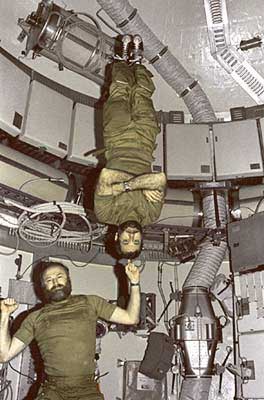
In the SkyLab orbiter, one astronaut balances another on his index finger. (photo courtesy of NASA)
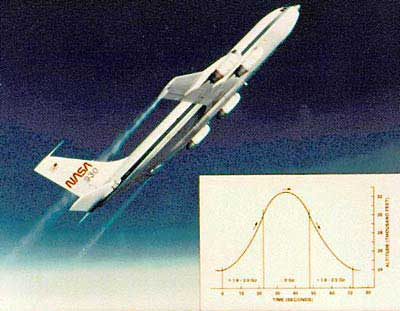
Astronauts-in-training affectionately call this aircraft the "Vomit Comet." To simulate microgravity, the Comet flies a parabolic arc for about 25 seconds, as shown in the inset. A typical training flight consists of flying about 40 such arcs. (photo courtesy of NASA).
Research
Why study fluids in space? For starters, understanding the way fluids behave without gravity may help scientists and engineers to better apply fluid phenomena on Earth- affecting applications like engines, power plants, and heating and cooling systems. Fluids are also integral to life support systems on spacecraft and better understanding of their phenomena is vital to further space exploration. As an example of this, let's examine boiling.
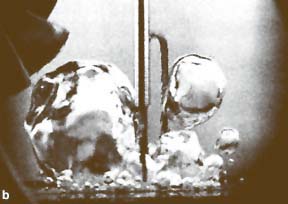
Boiling in microgravity (courtesy of NASA)
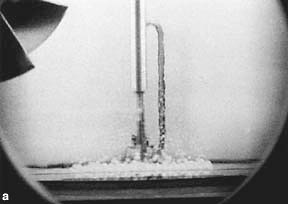
Boiling on earth (courtesy of NASA)
Fluids: A fluid is defined as any material that flows in response to an applied force. This means that besides the obvious fluids, water and liquids, air and gases are also fluids. Even the plasma that makes up the sun and stars is a fluid. And, most surprisingly, some solids behave like fluids--both soil and sand easily flow when a force is applied to it.
A pot of boiling water is something most of us can picture in our heads. Think about the role gravity plays in this everyday phenomenon. As the water heats, gravity causes the hotter regions of liquid to rise--a process known as "convection"--which distributes heat throughout the water. Once the water heats to the boiling point, the gravity-induced buoyant force sends the bubbles upwards, producing a "rolling boil." But this familiar picture changes drastically in a microgravity environment. Gravity-driven convection and buoyancy are non-existent, and without their dominating influence, scientists grow closer to understanding the fundamentals of boiling.
Given our dependence on boiling liquids in food and drink preparation, it is easy to imagine why scientists are interested in studying boiling phenomena. But, beyond the kitchen, boiling is used in many engineering systems as an effective means of transferring heat. Excess heat can be dispelled through the vapor bubbles moving through a boiling liquid. Although boiling figures prominently in the mechanics of heating/cooling systems, power plants, and engines, a better understanding of this phenomenon could lead to more efficient and effective applications.
Pool boiling experiments conducted onboard an orbiting space shuttle provided scientists the first glimpse of boiling in space. In gravity, vapor bubbles form on the heater surface of the liquid and, due to buoyancy, quickly rise to the top. In microgravity, without buoyancy, the bubbles remain attached to the heater surface and continue to grow. As these bubbles grow, the liquid is no longer in contact with the heater surface to cool it down and therefore, the liquid is useless as a heat transfer device. This situation can lead to "dryout" which is the suspected cause of the infamous Chernobyl disaster.
The space shuttle boiling experiments and future space station experiments are increasing our knowledge of boiling phenomena. These results will aid in our further exploration of space…. The final frontier.
Links
NASA
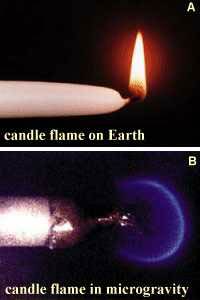
These photos show candle flames on Earth and in an orbiting spacecraft. In microgravity there is no convection, so the hot, evaporated wax from the candle does not rise. Instead, this hot gas slowly diffuses away from the wick and burns only when it reaches a supply of oxygen. The flame is spherically symmetric. (photo courtesy of NASA).
- Microgravity
- Microgravity Science Division
- "Vomit Comet" (simulation of microgravity)
- Drop Tower (simulation of microgravity)
- Flames in Space
- Bizarre Boiling














